Grab your doc file and spreadsheet fast before we run out of stock!

Dear Hot Shot Trucking Owner,
But Everyone Says This…Tell Me What’s Inside?
Here are just few of the questions answered in the business plan & financial model:
✔️Find out if it’s worth spending money and time into this idea.
✔️How much money can you make if you invest $X into this?
✔️Is $X amount of investment enough?
✔️When will the business break-even?
✔️Will you run out of cash if you invest $X amount?
Who is my target market?
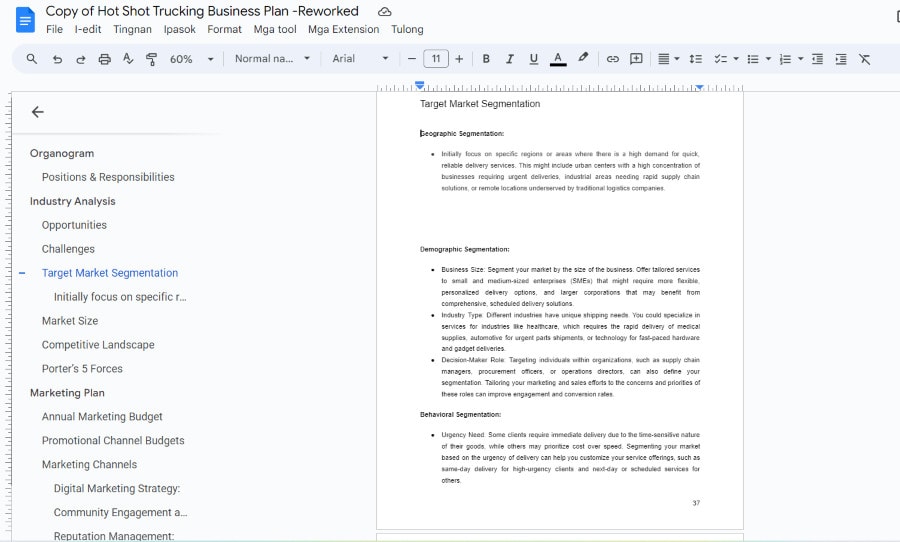
How do I acquire customers from my target market?

Grab your doc file and spreadsheet fast before we run out of stock!

Discover Our Impact on Several Hot Shot Truckings
Embark on an exhilarating journey to establish a hot shot trucking service that epitomizes efficiency and reliability. Leave behind any doubts and uncertainties as you step into the visionary role of a logistics entrepreneur. Our comprehensive guide lays out a direct path from your vision to the reality of a thriving hot shot trucking business. Begin this transformative adventure now – where both your future clients and yourself stand to reap the rewards. ✨ #ElevateYourLogisticsExperience #AchieveSuccess
Transition from idle dreams to making your hot shot trucking vision a present-day reality with our Hot Shot Trucking Business Plan and Financial Model Toolkit. Say goodbye to uncertainties and welcome a clear, well-defined route to success. Witness your hot shot trucking dream take shape, translating your ideas into concrete achievements. Let’s confidently confront and conquer any lingering fears as you take that important first step!
Bid farewell to hesitations and uncertainties as you embrace our hot shot trucking business plan and toolkit, offering a streamlined and actionable approach to launching your logistics business. Dive into your entrepreneurial journey now, moving from concept to the thrilling launch of your hot shot trucking service.
Step beyond ordinary templates with uninspiring projections and tedious data!
If the idea of launching your hot shot trucking venture sparks eager anticipation, rest assured! Our meticulously designed plan unveils every detail, guiding you seamlessly from initial concept to operational excellence, ensuring no critical aspect goes unnoticed.
Cut The Bullshit And Show Me Some Goddamn Pages For Free So I Know What I’m Getting Here!
Okay, okay…Now, before we make this magical little exchange where you give me money and I give you your very own copy of the template……..
Sample Business Plan
We have written a business plan and financial model using this template so that you get a clear idea on how powerful the template is!

Sample Financial Model

But My Hot Shot Trucking Is Different And This Won’t Work For Me…
How to Write the Hot Shot Trucking Business Plan?
I will write a complete business plan for Hot Shot Trucking Business Plan in this demo!
Step 1: Download the Business Plan
After you download the Business Plan then you will be redirected to the Thank You Page which contains link to the business plan template and financial model. The click on the Business Plan Template Button and Financial Model to use them.

Step 2: Start with the Financial Model & Industry Analysis
You should start the Business Plan from the Financial Model and Industry Analysis sections as it helps you build the structure of the overall business and your plan.
When you open the financial model then it looks like this:
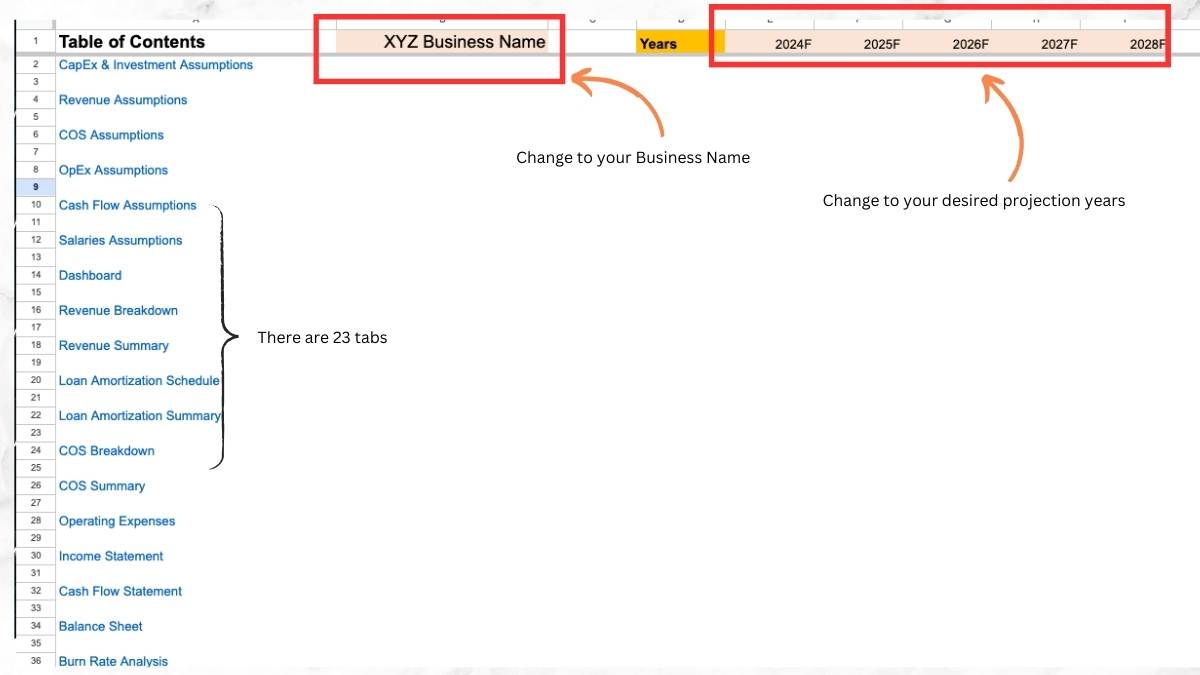
Step 2: Financial Model Starts with Investment
Uncover the ideal fleet size required to achieve an annual revenue of $500K for your hot shot trucking business. Whether you’re funding the venture independently or exploring financing opportunities, effortlessly input your data into the dedicated sections of our financial model. If you’re contemplating a loan with specific terms and interest rates, rest assured that our model will seamlessly handle all necessary calculations.
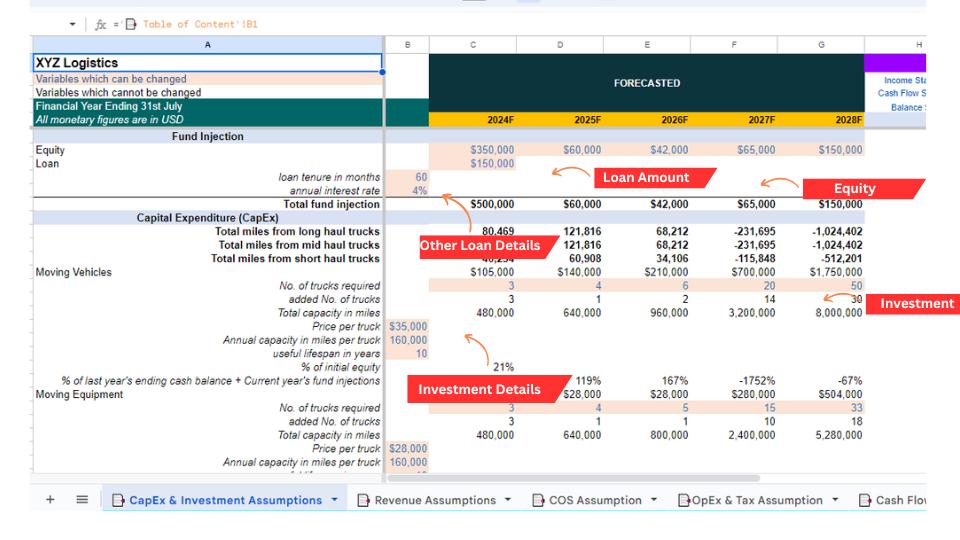
This section plays a pivotal role in our Hot Shot Trucking Business Plan and Financial Model, offering pre-set parameters to streamline your planning process.
You’ll enjoy the flexibility to choose from a variety of options, including different fleet sizes, and the ability to combine them for optimal efficiency. Our comprehensive research has determined the costs associated with various fleet setups, ensuring accurate projections without the need for extensive research on your part.
We’ve meticulously researched and incorporated prices for essential investment items such as trucks, trailers, and other critical assets into the model. This spares you the effort of independently sourcing this information. However, should you prefer to adjust any of the investment figures, you retain the freedom to do so.
.

Step 3: Revenue Assumptions
The success of your hot shot trucking business hinges on your ability to attract clients. To acquire customers, you have two primary strategies: increasing marketing expenditure or engaging with potential clients organically. Our Hot Shot Trucking Business Plan and Financial Model offers the flexibility to customize and adapt to these approaches.
Moreover, our model incorporates various promotional channels that you can utilize, including your company website, in-person marketing efforts, Google Ads, and more. For example, if you’re implementing in-person marketing and have three staff members dedicated to acquiring new clients through activities such as client visits or outreach calls, each with a monthly salary cost of $50K.
If, on average, they bring in 25 new customers monthly, the cost per customer acquisition totals approximately $2,000. With our model, you can adjust these variables to assess the profitability of your business and determine if your cash flow can sustain ongoing operational success.
.

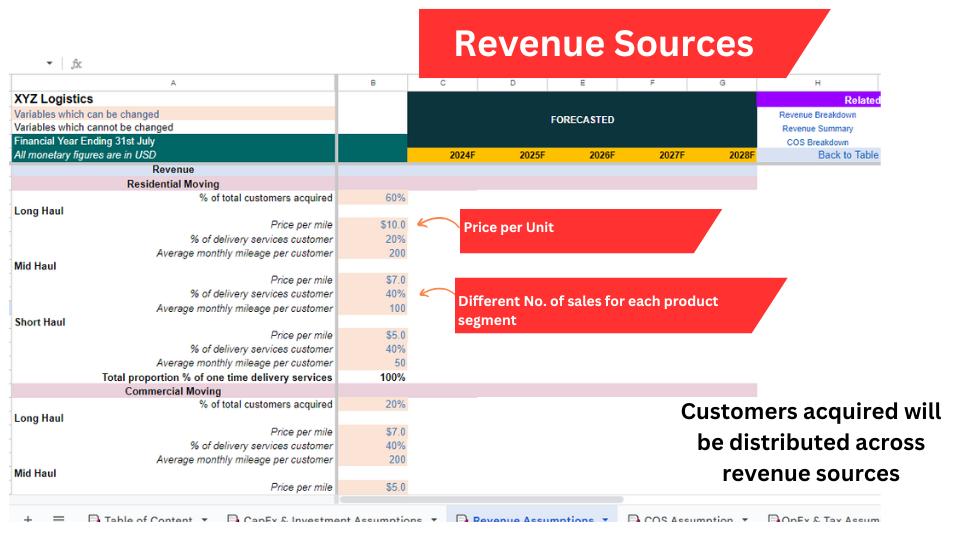
Let’s delve into the revenue model for your hot shot trucking business, aligning it with the client acquisition metrics previously discussed. In the initial year, let’s envision your business attracting 100 new clients. Among these, 70% opt for recurring services, demonstrating strong client loyalty or potentially a contract-driven approach, while the remaining 30% choose one-time services or shorter engagements. Therefore, 70 clients contribute to your Recurring Revenue, and 30 clients to your One-Time Revenue.
Diving deeper into the group of recurring clients, consider:
- 40 clients prefer frequent shipments, requiring multiple services per month (high frequency),
- 20 clients opt for regular but less frequent shipments, following specific schedules or seasonal patterns (moderate frequency),
- 10 clients request occasional shipments, perhaps for special projects or sporadic needs (low frequency).
This segmentation allows for a customized revenue structure tailored to the unique dynamics of your hot shot trucking business, offering precise revenue projections with detailed monthly breakdowns. Such a systematic approach enhances revenue forecasting accuracy by addressing new client acquisitions, retention rates, and turnover dynamics, all critical factors for financial planning and overall fiscal strategy.
Through monthly revenue projections, you gain valuable insights into client behaviors over time — encompassing new client acquisition rates, the percentage of recurring clients, and client retention levels. This comprehensive analysis supports accurate financial planning and empowers informed decision-making for the success of your hot shot trucking business.”
.

Step 4: Cost Assumptions
In the realm of your hot shot trucking business, distinguishing between variable and fixed costs is crucial for effective financial management. Variable costs fluctuate depending on the level of services provided to clients. For example, as your business handles more shipments, expenses for fuel, vehicle maintenance, and driver wages will increase. Additional variable costs may include tolls, insurance premiums, and equipment maintenance, which vary based on usage and workload.
On the other hand, fixed costs remain constant regardless of the number of shipments. These encompass expenditures such as vehicle leases or purchases, salaries for core personnel, insurance premiums, and office rent or lease payments. These costs remain stable regardless of changes in workload or client demand.
Following Generally Accepted Accounting Principles (GAAP) and standards from the Financial Accounting Standards Board (FASB), these costs are typically categorized as follows:
Cost of Goods Sold (COGS): This category includes all variable costs directly associated with providing transportation services. It covers expenses for fuel, vehicle maintenance, driver wages, and other direct costs related to shipment delivery.
Operating Expenses (OPEX): These represent your fixed costs, including all overhead expenses in operating the trucking business that are not directly tied to transportation services. This category encompasses vehicle leases or purchases, insurance premiums, salaries for administrative staff, office rent, marketing expenses, and administrative costs.
A clear understanding of these cost differentials is vital for accurate financial reporting, projecting future costs, and establishing competitive pricing strategies for your transportation services, ensuring profitability and sustainable operations.
.
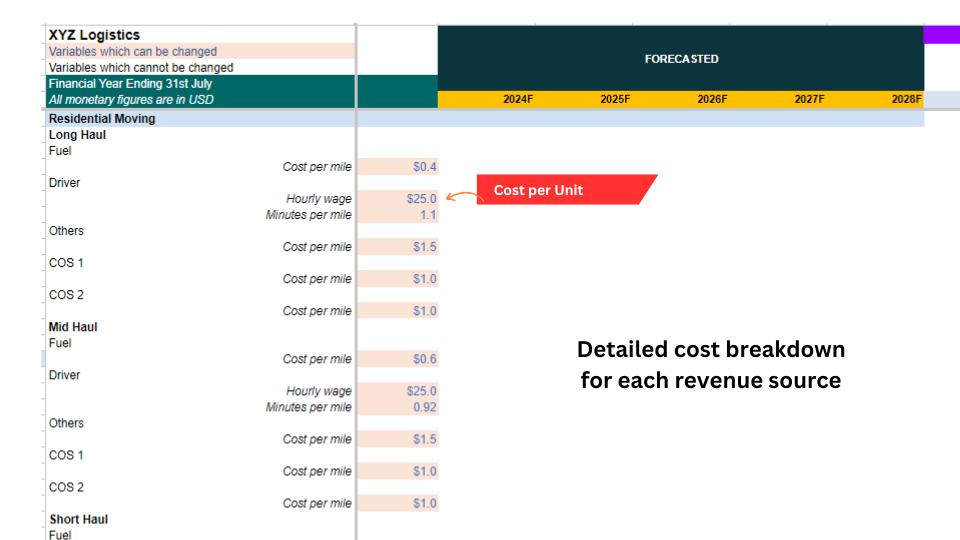
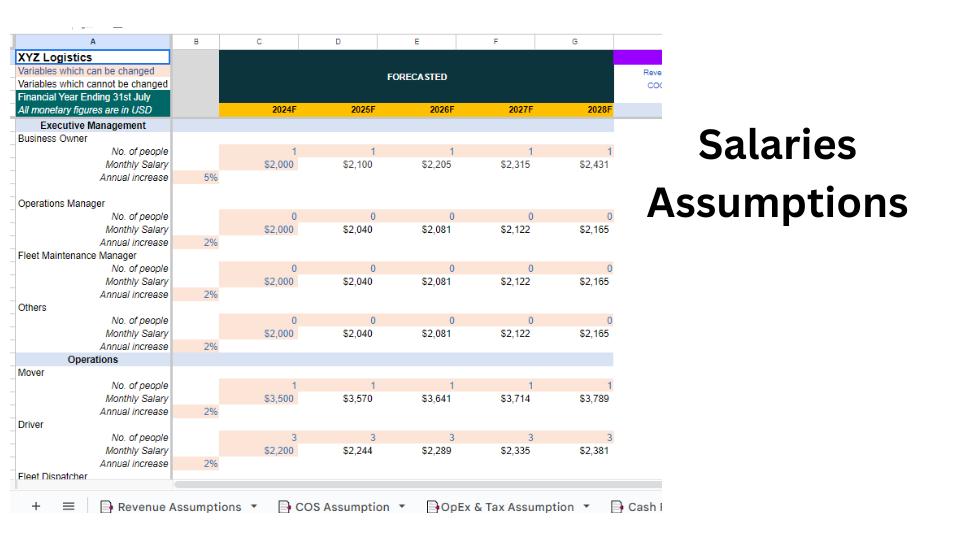

Step 5: Cash Flow Assumptions
Effective cash flow management is vital for your hot shot trucking business, requiring specific attention to client payments, vendor transactions, and fleet maintenance. Client Payment Considerations: Delays in client payments or settlements for transportation services can impact your accounts receivable, potentially affecting cash flow. Encouraging prompt payments through incentives or enforcing stricter payment policies can help address this issue.
Vendor Payment Considerations: Temporarily delaying payments to vendors for supplies, such as fuel, vehicle maintenance, and equipment repairs, can provide a short-term boost to cash flow. However, it’s crucial to manage these delays carefully to maintain positive vendor relationships. Negotiating extended payment terms proactively can improve cash flow without straining vendor partnerships.
Fleet Maintenance Considerations: Maintaining an optimal balance between vehicle maintenance and cash flow is essential. Overspending on vehicle repairs or parts can drain cash reserves, while neglecting maintenance can lead to costly breakdowns and downtime. Implementing preventative maintenance schedules and exploring cost-effective repair options can help manage expenses while ensuring fleet reliability.
These considerations are fundamental to your financial planning and cash flow management strategy. By effectively managing client payments, vendor transactions, and fleet maintenance, you can cultivate a more stable cash flow, streamline operations, and position your hot shot trucking business for sustained growth.
.
Now Let’s Dig Deeper….

Step 5: Analyze Results of the Financial Model
Now that all assumptions have been inputted into the model, what is the outcome?
Planning for Minimum Capital Requirements: Calculate the startup capital required based on estimated expenses for initial infrastructure setup, marketing efforts, vehicle acquisition, and operational costs aligned with your service objectives.
Cash Flow Analysis: Assess potential impacts on cash flow under various scenarios, such as lower-than-expected client volumes at the beginning, increased acquisition expenses, or unforeseen rises in vehicle maintenance costs. This analysis assists in understanding your trucking business’s financial resilience without significant initial investments.
Exploring Financing Options: Utilize this financial model to determine total capital needs, rationale behind the amount, intended allocation of funds, expected timeline for achieving profitability, and comprehensive strategies to meet financial objectives when exploring financing options such as loans or investor support. It also supports your client service forecasts and expansion plans with robust data and evaluations.
Viability Assessment: Evaluate the feasibility of starting a hot shot trucking business by analyzing market demands, competitive landscape, pricing strategies, and cost structures.
Strategic Planning for Established Businesses: For existing trucking businesses, this financial model offers an impartial assessment to refine strategies, optimize operations, and strategically plan for future growth or the introduction of new services.
.



Step 6: Start Writing The Business Plan with Industry Analysis
Begin the business plan with an industry analysis, as this will aid in fine-tuning the details within the financial model. When conducting the competitive landscape analysis as part of the industry study, it’s crucial to gather pricing and relevant information about competitors. This might entail retrieving pricing details from competitors’ websites or social media profiles, and in some instances, direct engagement with competitors may be necessary. Understanding competitors’ pricing structures will help in establishing the most suitable pricing strategy, which can then be incorporated into the financial model.
Step 6: Marketing Plan
Commence your marketing strategy by outlining the promotional channels you intend to leverage. Building on the insights gathered from the competitive landscape analysis in the previous industry analysis section, you can identify the promotional channels utilized by your competitors. There are tools available to assess performance across these promotional channels for a specific business; for instance, Semrush can provide data on the number of visitors to a competitor’s website per month. This information can offer valuable insights into a competitor’s popularity. Additionally, you can analyze the most visited blog pages by the target market on your competitors’ website to uncover engaging topics for your own target audience.
Step 7: Operational Overview
Step 8: Organizational Overview
Develop a roster of employees you intend to hire, detailing their salaries and any additional benefits. Offer job descriptions for each role. Subsequently, construct an organizational chart depicting the hierarchy within the team structure.

Choose and personalize! The positions and job descriptions most fitting for the hot shot trucking business plan have been provided. Retain the essentials and adjust as necessary. The requirements for each trucking operation vary. For instance, if you are partnering with external maintenance services, in-house mechanics may not be necessary..
Step 9: Executive Summary + Other Sections
Make a list of personnel that you plan to recruit, their salaries and other benefits. Write down the job description of each position. Then create an organogram with appropriate hierarchy.
Reviews
340+ Downloads & Counting

The hot shot trucking business plan templates and financial model have been a game-changer for my startup. They’re incredibly detailed and easy to use, making my business planning a breeze.
★★★★★
I was hesitant at first, but the template and financial model have exceeded my expectations. They’ve provided me with a roadmap for success in the cigar lounge business.
★★★★★
The hot shot trucking business plan is well-structured and comprehensive. Combined with the financial model, they’ve given me a clear understanding of the box truck market and its potential.
★★★★★
I’m impressed with the quality of the financial model. It had a lot of info which I did not even think of earlier.
★★★★★
F.A.Q
Yeah but will this template help me get a loan?
Maybe. This mostly depends on your business idea, previous experiences, ability to provide collateral and relevant factors. This is a template for present your plan in the best possible way. In addition, the financial model helps to validate your business concept or your expansion plan. It’s kind of hard to provide more for just $49.
Is the payment secure?
Our payment is processed by Stripe or PayPal so you can rest assured about your data privacy and security.
What is the refund or cancellation policy?
Due to the fact that templates are downloaded, we cannot give refunds.
Digital material is exempt from the 14-day return policy applicable to physical products. Because of this, our downloadable content are non-returnable. All sales are final. You can also check out the video in the product page to get an idea of contents of the template. This should help you get a clear idea on the features of the product.
However, we do value the customer experience and are accessible to assist you with any problems you may have while using our goods. If you have particular queries regarding our product, please use the chat box on this page or send an email to [email protected].
How can I edit the template?
Simple. If you are using Google Doc and Sheets then just make a copy in your own Google Drive. In case you are using Microsoft Office then Download the files and start editing.
What about support?
You can email us at [email protected] and we will respond in 24 to 48 Hrs. We offer in-person or email based support depending on your needs.
Every other reason for not buying....
❌ “But you can’t replace hiring a business plan writer to do this”
✅ This template costs $49 not $2,000. Also, you have more control over the writing process. The template is very specific so you will have relevant info in Industry Analysis, Financial Model and other sections.
❌ “I feel like just browsing online and using the free templates available online.
✅ Sure, if you wish to spend 4 weeks instead of 2 days to write a plan then please go ahead. Our research team found that free resources are very generic and does not offer fill-up and use facility. Also, you won’t get the specialized financial model from the free resources.
❌ But wouldn’t everyone’s content look the same?
✅ Nope. Our customers are smart and customize by adding their own images, logo, company description, etc.
❌ “But can you guaruntee that I will get a bank loan using this?
✅ No, I cannot guarantee anything for $49. The purpose of this template is to make it easier and less time consuming for you to write a business plan.
Who developed this template?
Our templates are developed by CPAs, CFAs and Ex- consultants of BCG, Mckinsey, PwC and KMPG. Elma Steven is the Head of our Quality Control.
Can I validate my the prospect of my MVP using this?
Yes. The financial model will help you plug in price, unit cost, payables and other assumptions which will allow you to project the revenue, profit and other KPIs.






